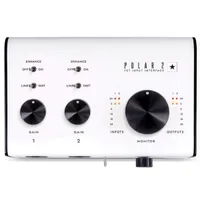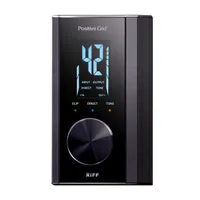Best guitar audio interfaces 2025: Record killer guitar parts at home with our top picks
The best audio interfaces for guitar from IK Multimedia, Focusrite, UAD and more
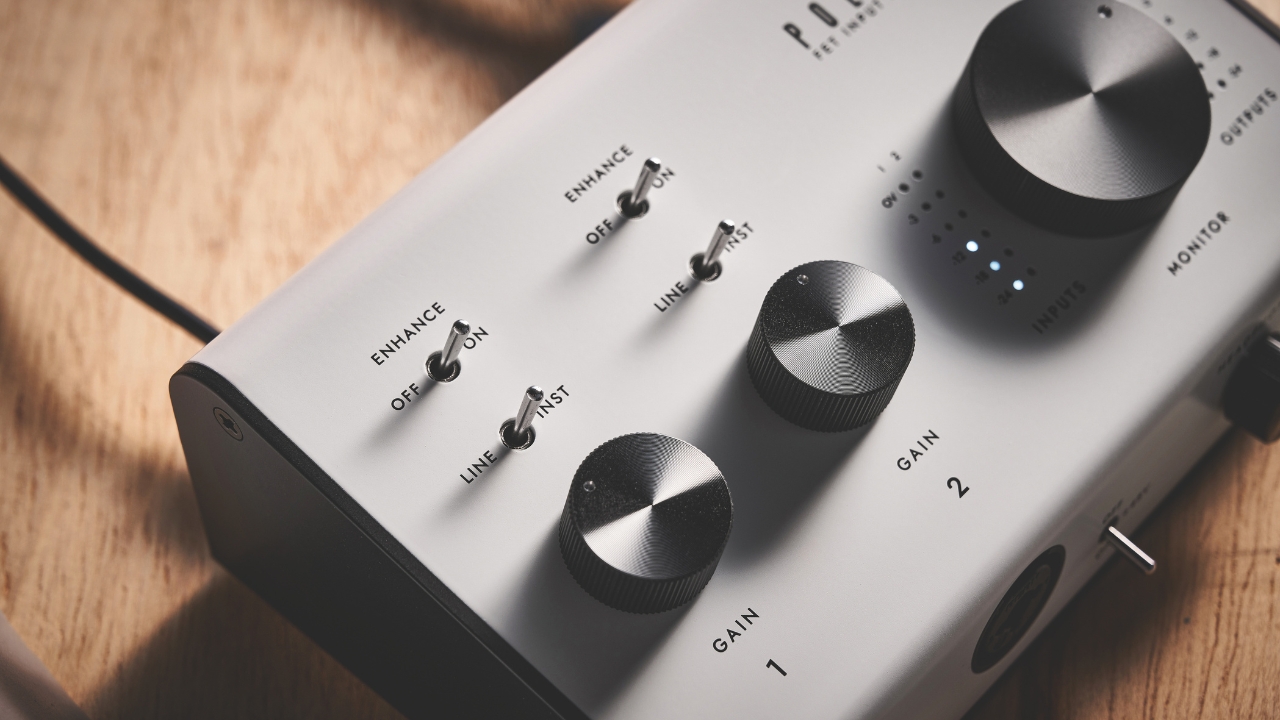
If you’re a guitarist, chances are you’ll be after recording yourself at some point or other. Your route to at-home or on-the-go recording is, of course, the humble audio interface – an essential and now-ubiquitous piece of kit that lets you record sounds into your computer. There are many on the market, but which are the best audio interfaces for guitar?
Even if you don’t have designs on becoming the next Eric Valentine or Jack Antonoff, you still stand to benefit greatly from being able to record your guitar chops at home – whether in service of writing and developing your own music, or simply to track your progress as you become a better guitarist.
I've personally tested a huge variety of audio interfaces for this guide, and as a guitarist and recording musician of over 20 years it's safe to say I know my stuff. Each interface in this guide has been rigorously tested for build quality and usability, and had its software offering fully explored, ensuring that only the most useful options make this guide.
If you're looking for the best overall guitar audio interface, then we'd go for the IK Multimedia Axe I/O. It's one of few guitar-specific interfaces out there and comes with plenty of features that make tone-shaping super easy. It's not the cheapest though, so if you want something on a budget, then the IK Multimedia iRig HD X is a fantastic choice, coming in just below the $/£100 price point.
Picking a guitar audio interface is at once simple and not-so-simple – and if you want to get to grips with the not-so-simple, you can head over to our FAQs section, where you’ll find loads of common questions and in-depth principles tackled in earnest. If you just want to know what to record your guitar through, though, feel free to read on!
My top picks
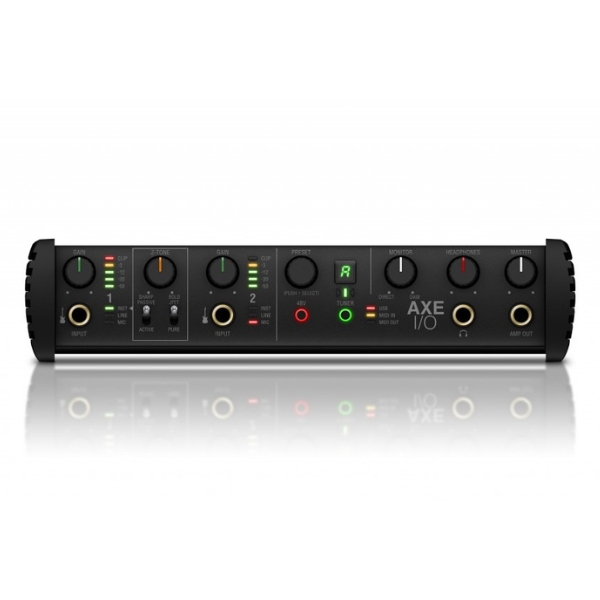
The only audio interface on this list specifically designed for guitar, it makes total sense that the IK Multimedia Axe I/O is our top pick. Featuring loads of guitar-specific features like active or passive pickup switching and an amp-out connection for reamping, for guitarists it doesn't get much better than this.

IK Multimedia’s iRig HD X is a highly portable guitar audio interface, and one which crams a whole lot of functionality into its meagre form. Handy amp-out and loopback functions let you weaponise your digital effects library in recordings and through your amps, and the one-knob functionality is near-foolproof.
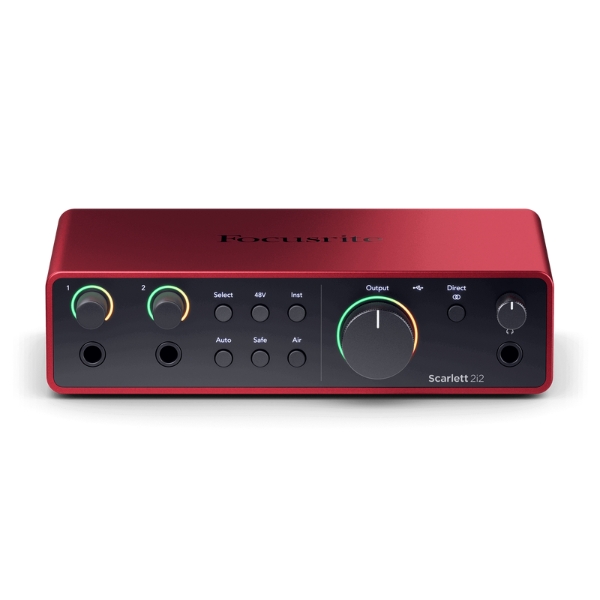
If you're a Windows user, then the Focusrite Scarlett 2i2 4th Gen is the best guitar interface for PC. Rock solid drivers deliver excellent low latency performance coupled with loads of useful workflow features that'll make recording your guitar a breeze. It works brilliantly on Mac machines as well.
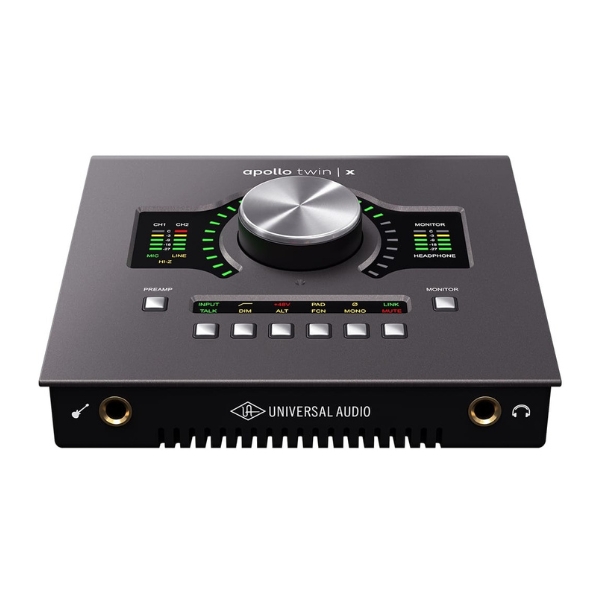
If you're recording guitar on Mac, there's no better experience than the Universal Audio Apollo Twin X. Its powerful onboard DSP processing gives you an analogue studio experience, and we prefer using it on Mac versus Windows due to the Thunderbolt connectivity.
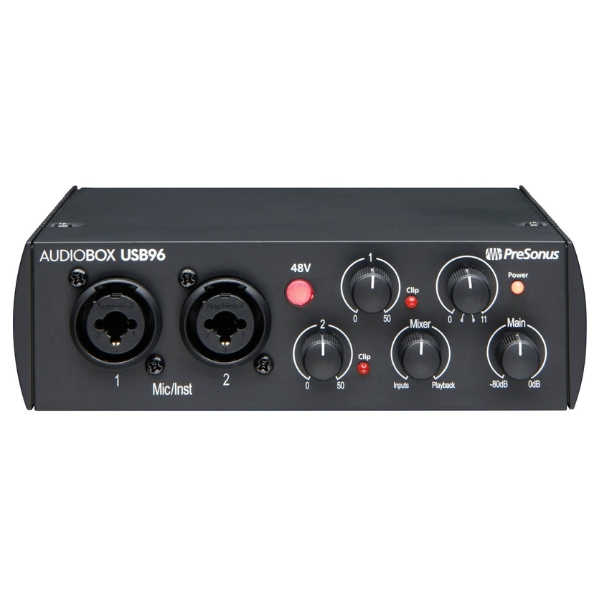
To be totally honest, you could use any of the interfaces on this list with your bass guitar but for us, the PreSonus Audiobox USB 96 is a great choice thanks to its low cost and excellent software bundle. Crystal clear preamps make for a great bass DI and it features MIDI for external controllers.

For reliable performance with an iPad, it doesn't come much better than the Motu M2 for us. Bus-powered with ultra-low latency and featuring professional-level digital audio converters, it's not the cheapest out there but if you want a solution to record your guitar with an iPad it's a brilliant choice.
Best overall

Specifications
Reasons to buy
Reasons to avoid
✅ Buy if you want a guitar-specific interface: This is one of few audio interfaces designed specifically for guitar, so it packs loads of useful features for guitar players that make recording guitars easy.
❌ Avoid if you prefer simplicity: With so many features it can be a little bit distracting having so many tone-shaping options. So for those who like things simple, you may wish to look elsewhere.
Overview: Tone is an essential consideration for every recording guitarist, and the Axe I/O comes with bucketloads of options, thanks to the inclusion of IK Multimedia’s Amplitube 4 Deluxe amp/FX modeller which features digital amplifiers, cabinets and stompboxes, as well as an eight-track recorder and looper.
Features: If you prefer ‘out of the box’ recording, the Axe I/O has you covered with twin mic/line connectors for stereo recording and a reamp option to re-record DI’d parts through your favourite guitar amp.
With phantom power for condenser mics, MIDI/expression pedal connections to control Amplitube 5, as well as an onboard tuner, the Axe I/O proves to be one of the best-equipped audio interfaces available specifically for guitarists.
Software: Being a guitar-specific interface, it comes with both Amplitube 5 SE and Tonex SE, so you'll have plenty of amp and effects models to use for your recordings. It also gives you Ableton Live Lite if you don't currently have a DAW, but compared to some of the others on this list it is a little light in the software department.
Performance: Actually using the Axe I/O can be a little overwhelming at first, particularly if you've never used an audio interface before. Once you get the hang of it though, it gives you a lot of power over the sound of your guitar. I love the switchable inputs that allow for active or passive pickups, as well as the ability to switch between an ultra-clean preamp mode and the JFET mode that adds some warmth and saturation to your tone.
The Z-Tone knob is very powerful, allowing you to change the impedance of the guitar tone which can make it sound darker or brighter. If you have a Telecaster for example with its notoriously bright bridge pickup, you can tame this a little if the recording demands it, and vice versa if you have a dark humbucker-equipped guitar.

"As audio interfaces go, this one has decent specifications and all the facilities you’d need for standard recording tasks and being able to take input from microphones, line-level sources and instruments. But where many simply have a one-size-fits-all instrument input, the dedicated Number 1 guitar input here can make a real difference in the quality of your guitar recording. Not just that, the Amp Out facility makes getting signal to your amp and back into the DAW a real doddle."
Read more: IK Multimedia Axe I/O review
Best budget
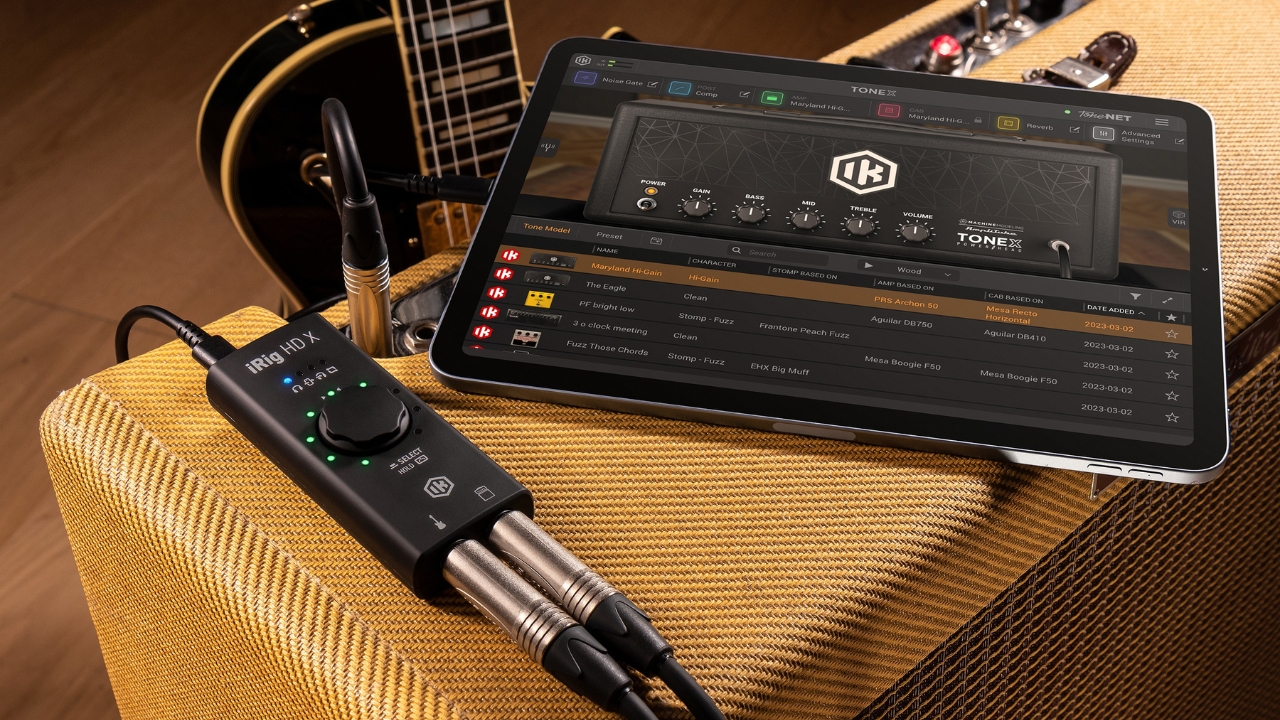
Specifications
Reasons to buy
Reasons to avoid
✅ Buy if you want to watch your budget: Coming in just below the $/£100 mark, this super simple and compact audio interface from IK Multimedia is the perfect choice for the recording guitarist on a budget.
❌ Avoid if you're using an Android device: It doesn't currently support Android which is a shame, so if you want to use a non-Apple smartphone to record your guitar you'll need to look elsewhere.
Overview: The iRig HD series has been a popular one here at MusicRadar, as evidenced by the iRig HD 2’s positive reception a few years back. IK Multimedia’s latest guitar-centric audio interface, the iRig HD X, continues in the same impressive vein, funnelling practicality into a unit designed to favour portability.
Features: There are a good few nifty features with the iRig HD X, from its onboard tuner to its high-fidelity sound capture, but my personal favourite is its dedicated amp-out jack. Rather than just recording your riffage, the HD X can also send an instrument-level signal back out to an amp (or, indeed, your destination of choice), either exactly as it came in or after processing in your DAW.
Software: Just like it's big brother in the Axe I/O, the iRig HD X features both Amplitube 5 SE and Tonex SE as part of the bundle. It gives you some of the best modelled tones available right now, and plenty of choice when it comes to amps and effects. As with the Axe I/O, it is a little lean in terms of mixing tools compared to others, so you'll need to build your own collection or rely on the stock plugins in your DAW.
Performance: Naturally, this means you can capture DI guitar recordings and play out loud simultaneously – a godsend for capturing ideas during lengthy songwriting or practice sessions – but it also means you can benefit from amp emulation and other computer-borne effects while playing in the room. A good thing, too, since buying the iRig HD X also gets you both Amplitube 5 SE and TONEX SE, which between them offer hundreds of amp sounds and guitar effects. Even better, the iRig HD X’s new and nifty Loopback+ mode lets you insert one of these apps into your signal chain before recording audio into a device.
Best for PC

Specifications
Reasons to buy
Reasons to avoid
✅ Buy if you want the best guitar interface for PC: With fantastic driver support and low latency performance on Windows, the Scarlett 2i2 4th Gen is our pick for PC and Windows laptop users.
❌ Avoid if you want a direct monitor button: The direct monitor option can only be accessed via software, so avoid if you like to hear the sound of your guitar going into the interface.
Overview: Focusrite audio interfaces have an enviable reputation for high-quality mic preamps and digital converters – a quality which can be found in their latest Scarlett 2i2 model. The dual inputs feature Focusrite’s ‘Air’ effect for a taste of the company’s classic ISA preamps, offering both a high-end and mid-boost function.
Features: This new version does away with the combination inputs, leaving just 1/4" jack inputs for your guitar on the front, and XLR inputs on the back should you want to mic up your amplifier or cabinet. Some may love this, but it could prove divisive if you perfer combi inputs on the front.
The brand-new auto gain and clip-safe features ensure you'll never overload your input and get a clipped audio source, which means your gain staging will always be at the right amount. We love the fresh look of the new 2i2 as well, with its handy coloured display meters for your inputs and outputs, tactile knobs, and sleek front end with soft touch but sturdy buttons.
Software: The Focusrite Hitmaker Expansion gives you a very encompassing software package with mixing tools, virtual instruments, and most importantly in this case, amp simulator software. With Softube's excellent Marshall amp emulation plus XLN’s Addictive Drums 2: Studio Rock Kit you'll be crafting your own tunes in no time.
Performance: For all round music-making, Focusrite's interfaces are amongst the best out there. Their real strength is in how easy they are to use, and in the amount of features they give you for a relatively low price point. Of all the interfaces I've reviewed, I find it remarkable just how easy it is to get great results with the Gen 4 Focusrite interfaces.

"Although they look similar, the new Scarletts are slicker audio interfaces with better specs and more options. I'm inevitably drawn towards the great new features on the 2i2 and 4i4. The latest versions of this very popular range show there’s always room for development, and the new features particularly in the 2i2 and 4i4 will help improve your productivity and recordings."
Read more: Focusrite Scarlett 2i2 4th Gen review
Best for Mac
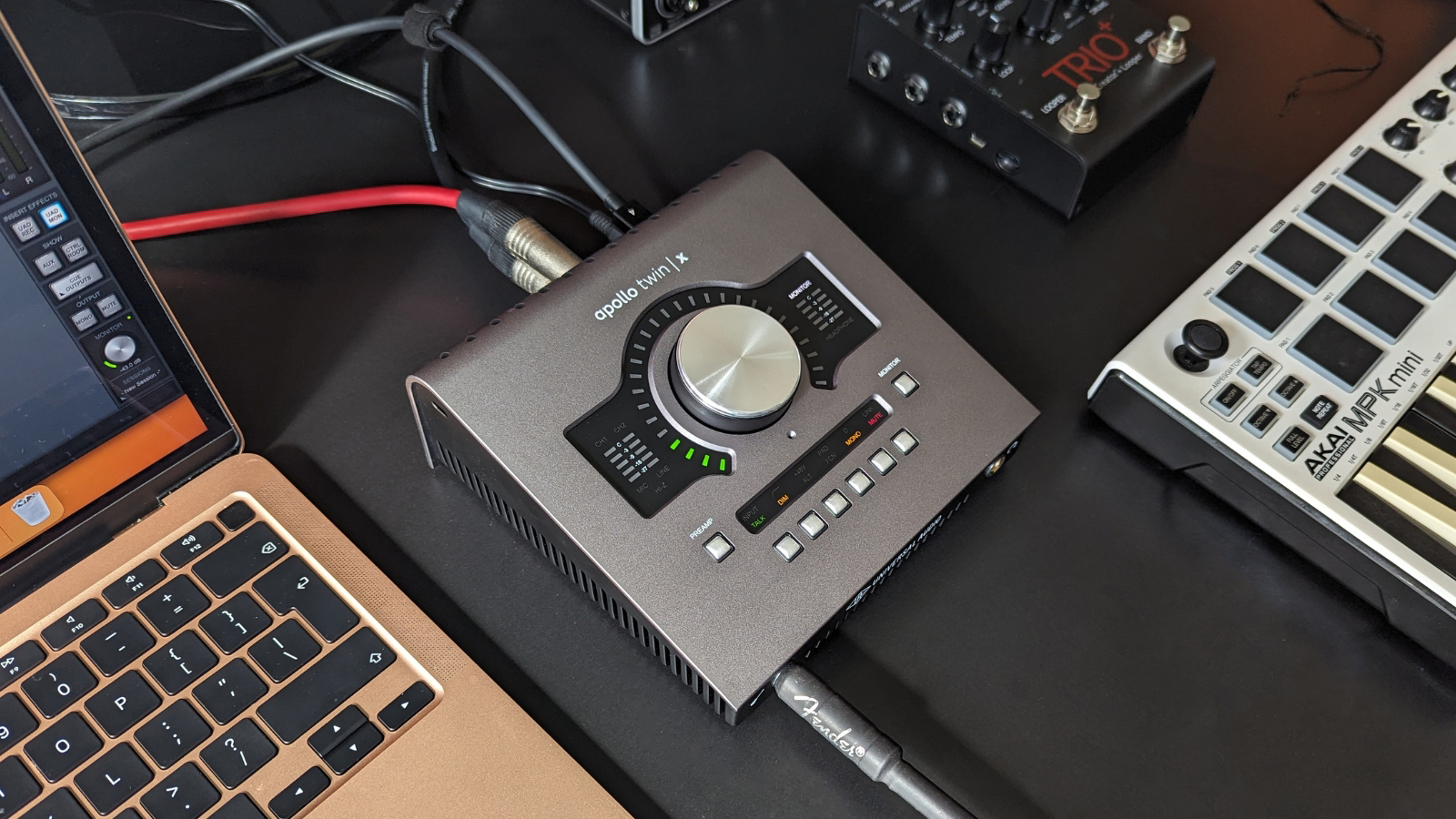
Specifications
Reasons to buy
Reasons to avoid
✅ Buy if you want a high-end audio interface for Mac devices: With its Thunderbolt connectivity, the Apollo Twin X is a great match for Apple devices which tend to come with Thunderbolt as standard.
❌ Avoid if you only have USB available: If your laptop or PC doesn't support Thunderbolt then you won't be able to use this audio interface with it, or you may have to invest in a potentially expensive Thunderbolt card.
Overview: Arguably one of the most powerful audio interfaces around at the moment, the Universal Audio Apollo Twin X is the perfect match if you're recording your device through a Mac. The Thunderbolt connection comes as standard on Mac, whereas not all Windows devices have this so although you can use it on Windows, you may find you need an add-on card or converter to do so.
Features: It's a heavy and ruggedly built piece of kit, with a great feature set of buttons on the front that ensure a speedy workflow. There's plenty of connectivity on board with two mic/line-ins, a dedicated guitar input, four outputs, and an ADAT connection for expanding your inputs.
Software: When installing for the first time on a Silicon-chip Mac you might find the process convoluted like I did. There's a myriad of steps to follow that include restarting your Mac in a particular mode, and many options to check off to ensure it runs smoothly. It's a pian, but is absolutely worth the effort.
As well as UA's free DAW Luna, you also get some of their most popular plugins, with their famous LA-2A and 1176 compressor plugins alongside some great Pultec EQs, and for guitarists specifically, a Marshall Plexi amp model and an Ampeg SVT model for bass guitar.
Performance: I love the Apollo Twin X for its analogue studio-style workflow. The onboard DSP-processing power means you can load plugins before you record, tweaking your tones prior to it going into the DAW which is exactly what happens in actual recording studios. The on-board processing of the Apollo Twin X also makes latency levels absolutely tiny which is great for guitar playing.

"The workflow takes some getting used to coming from outside the UAD ecosystem, and it’s a while before you’ll get things set up exactly how you want them but in my opinion, it’s totally worth the time and financial investment. It’s clear why many pro engineers we know use these in their home or travel setups, from the solid build of the hardware, to the ingenious way it promotes an analogue workflow."
Read more: Universal Audio Apollo Twin X review
Best for bass
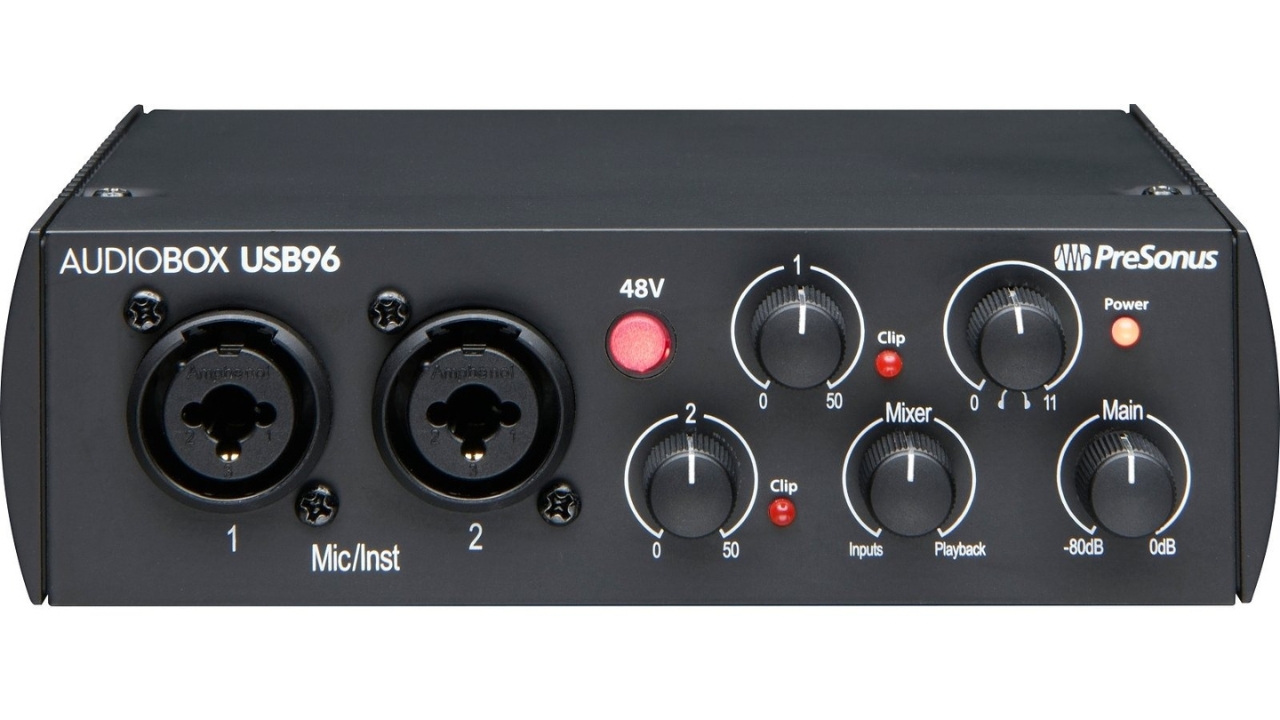
5. Presonus Audiobox USB 96 25th Anniversary Edition
Our expert review:
Specifications
Reasons to buy
Reasons to avoid
✅ Buy if you want a great budget audio interface for bass: Our pick for bass guitar due to its great quality preamp and excellent software bundle, the AudioBox 96 is fantastic value for money too.
❌ Avoid if you want your interface to look good: It's a black box essentially, so if you're looking to add some visual vibes to your studio then this probably isn't the interface you're looking for.
Overview: You can use any interface for bass guitar, but we've given the Presonus Audiobox USB 96 25th Anniversary Edition our nod thanks to its combination of extra features, usability, and ultra-low cost.
Features: The interface is bus-powered, which means you can take it anywhere and run it directly from USB. Mobile laptop recording, anyone? Yes indeed! And, with 48v phantom power, dual mic/line inputs and MIDI I/O for use with external controllers and expression pedals, it’s fair to say that Presonus’ robust little box delivers everything a guitarist could need without any unnecessary extras!
Software: Presonus have cannily delivered an impressive package in the Audiobox 96 USB thanks to the inclusion of their Studio One DAW and Studio Magic plugin suite. Just install the software to your computer, connect up, then plug your guitar into the Hi-Z input and start recording in one of the most respected DAWs on the market.
Performance: Like their excellent DAW, the Audiobox is a breeze to use, and I particularly enjoyed using the physical knobs for control rather than having to resort to software like a lot of modern interfaces do. You may prefer it the other way around of course, but there's something satisfying about turning knobs.
It's compact size makes it a great travel option too, allowing you to easily pack it into a backpack. It's ultra robust build makes it well-suited to travel too, without having to fear it being damaged in transit.
Best for iPad
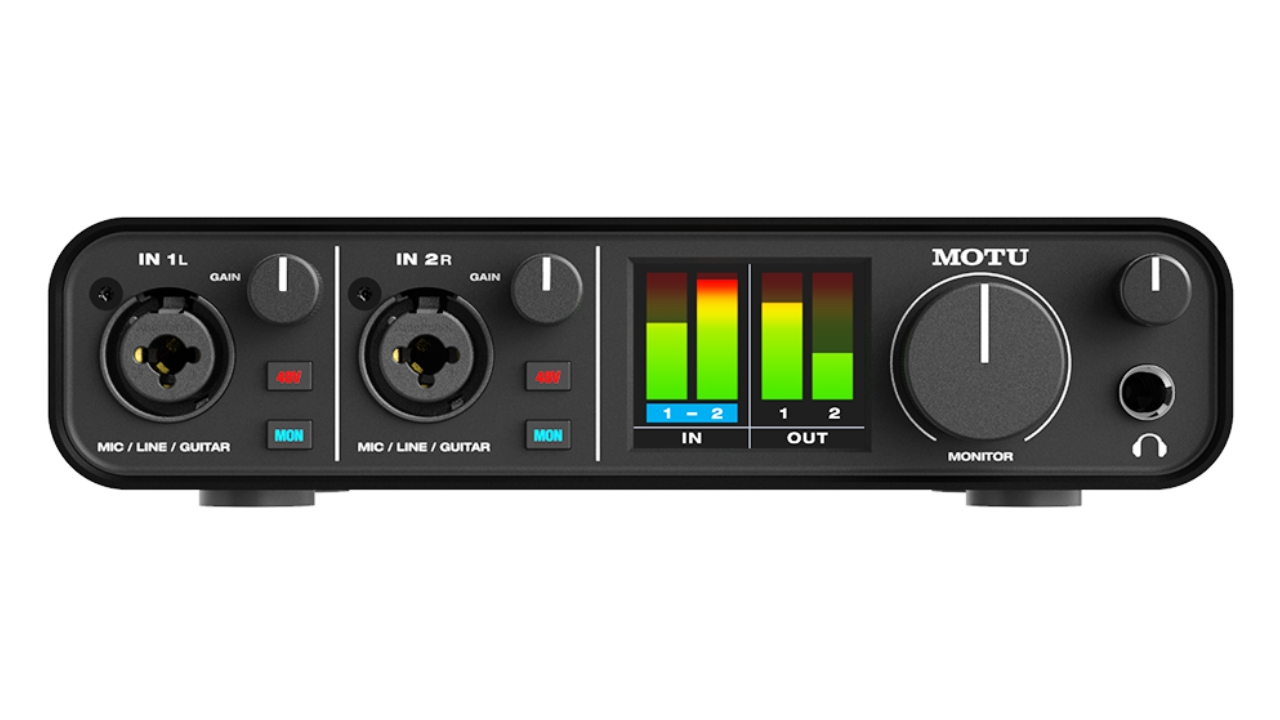
6. Motu M2
Our expert review:
Specifications
Reasons to buy
Reasons to avoid
✅ Buy if you want a great budget audio interface for bass: Our pick for bass guitar due to its great quality preamp and excellent software bundle, the AudioBox 96 is fantastic value for money too.
❌ Avoid if you want your interface to look good: It's a black box essentially, so if you're looking to add some visual vibes to your studio then this probably isn't the interface you're looking for.
Overview: Working with an iPad can be a fickle beast at times thanks to limited connection options and issues with powering bus devices. For us, the Motu M2 provided the most reliable performance when paired with a tablet, making it our top pick for recording your guitar alongside Apple’s compact but powerful device.
Features: We absolutely love the high-definition screen on the front, which gives you a usable way to measure your input gain versus the halo lights you typically see on modern interfaces. It also means making for one less bit of software you need to have open on your device, and makes it easier to switch between different instruments without having to resort back to software to see your levels.
Software: The software bundle here isn't the biggest, so you'll need to rely on your own collection or buy things in addition if you're using the M2 for recording with your iPad. The driver performance was very good during my tests though,
Performance: The latency figures are amongst the best we’ve seen at the consumer-interface level, making it great for playing with guitar VSTs, synth plugins, and any other software. The converters are the same that feature in Motu’s thousand-dollar interfaces, so you’re assured of great quality sound too.
Spec comparison
If you're struggling to decide between the options on this list, my handy spec comparison table gives you all the key features in one place.
Model | Connectivity | Resolution | Ins | Outs | Digital | MIDI |
|---|---|---|---|---|---|---|
IK Multimedia Axe I/O | USB 2.0 | 24-bit/192kHz | 2 | 5 | No | Yes |
IK Multimedia iRig HD X | USB-C | 24-bit/96kHz | 1 | 1 | No | No |
Focusrite Scarlett 2i2 4th Gen | USB 2.0 | 24-bit/192kHz | 2 | 2 | No | No |
Universal Audio Apollo Twin X | Thunderbolt | 24-bit/192kHz | 2 | 6 | Yes | No |
Presonus Audiobox USB 96 | USB 2.0 | 24-bit/96kHz | 2 | 2 | No | Yes |
Motu M2 | USB 2.0 | 24-bit/192kHz | 2 | 2 | No | Yes |
Also consider
Audient iD4 MKII
USB | 2-ins | 2-outs | No MIDI
There’s a saying that quality doesn’t come cheap. Well, one look at this interface suggests the folks at Audient are not living by that old adage. A simple two-in/two-out USB interface, the iD4 includes class A mic preamps from the company’s high-end consoles, and high performance digital converters too – all wrapped up in a robust all-metal casing.
★★★★½
Read more: Audient iD4 MKII review
Blackstar Polar 2
USB | 2-in | 2-out | No MIDI
Blackstar’s first foray into the world of audio interfaces is surprising, not just for the brand’s prior preoccupation with guitar amps but also for how straight-up good it is. The Blackstar Polar 2 is a 2-input, 2-output audio interface tooled specifically for guitarists, though it is decent enough to hold its own against a stacked general population of small budget audio interfaces.
★★★★½
Read more: Blackstar Polar 2 review
Positive Grid Riff
USB | 1-in | 1-out | No MIDI
Positive Grid has stripped back the Riff to its bare essentials, giving you only one control on the front of the unit. This oversized control knob allows you to adjust various parameters of the Riff, from the input and output levels, direct monitoring level - for zero-latency tracking - and even switch between three preamp emulations. This knob is also fully customizable and can be assigned to perform tasks such as changing amp models within Bias FX 2.
★★★★☆
Read more: Positive Grid Riff review
Audient Sono
USB | 2-in | 4-out | No MIDI
Combining a 12AX7 valve preamp and three-band tone controls with Two Notes Torpedo power amp modelling and cab simulation, Audient’s Sono is aimed squarely at guitarists. The valve offers analogue warmth and you can drive it harder with both gain and tone controls – just like a real tube amp! Dial in one of Torpedo’s 20 included amp/cab models and there’s enough heft for medium-gain rock and blues tones.
★★★★☆
Read more: Audient Sono review
How to choose

There's a lot of audio interfaces to choose from these days, so doing your research to make sure you get the right one is paramount. I've marked out all the steps here that you should take before purchasing to ensure you get the right audio interface to record your guitar playing.
1. Work out what you need
The first step is look at exactly what your needs are. Are you looking just to practice your playing through an audio interface or to start recording your debut solo album? There are a lot of different features available that will make your life easier depending on what it is you're doing with your guitar recording so before you've even thought about which interface you want, you should be considering what you're going to use it for.
2. Make a shortlist
With your needs firmly in mind, it's time to make a shortlist of however many interfaces you like the look of. This might be two or it might be five depending on what you're wanting to do with your guitar, but it's the logical next step to take.
3. Read reviews
Now you have your chosen interfaces, it's time to start reading reviews. Nearly all of the interfaces in this guide have a review, but it's good to read as far and wide as you possibly can. Always be careful with things like user reviews however, as these aren't often the most objective.
4. Compare interfaces
During the process of reading reviews you should be gaining more insight into what the interfaces can do, so directly comparing the features and functionality of your shortlist will help you narrow down your choices. You might want to list pros and cons of each to see which you prefer, or look at the different specs and stats that each has to help you make your decision.
5. Choose your retailer
Now that you know which interface you want, it's time to go shopping! You could use your favorite retailer, but in my experience it's always good to shop around. You never know who's going to potentially have a discount on an item, and you can use the Google Shopping feature to sort items by price.
6. Wait for a sale
If you're the patient type, you could even wait for a sale to save yourself even more money. Events like Presidents' Day, Memorial Day, or Black Friday all offer great opportunities to save big money on audio interfaces.
FAQs
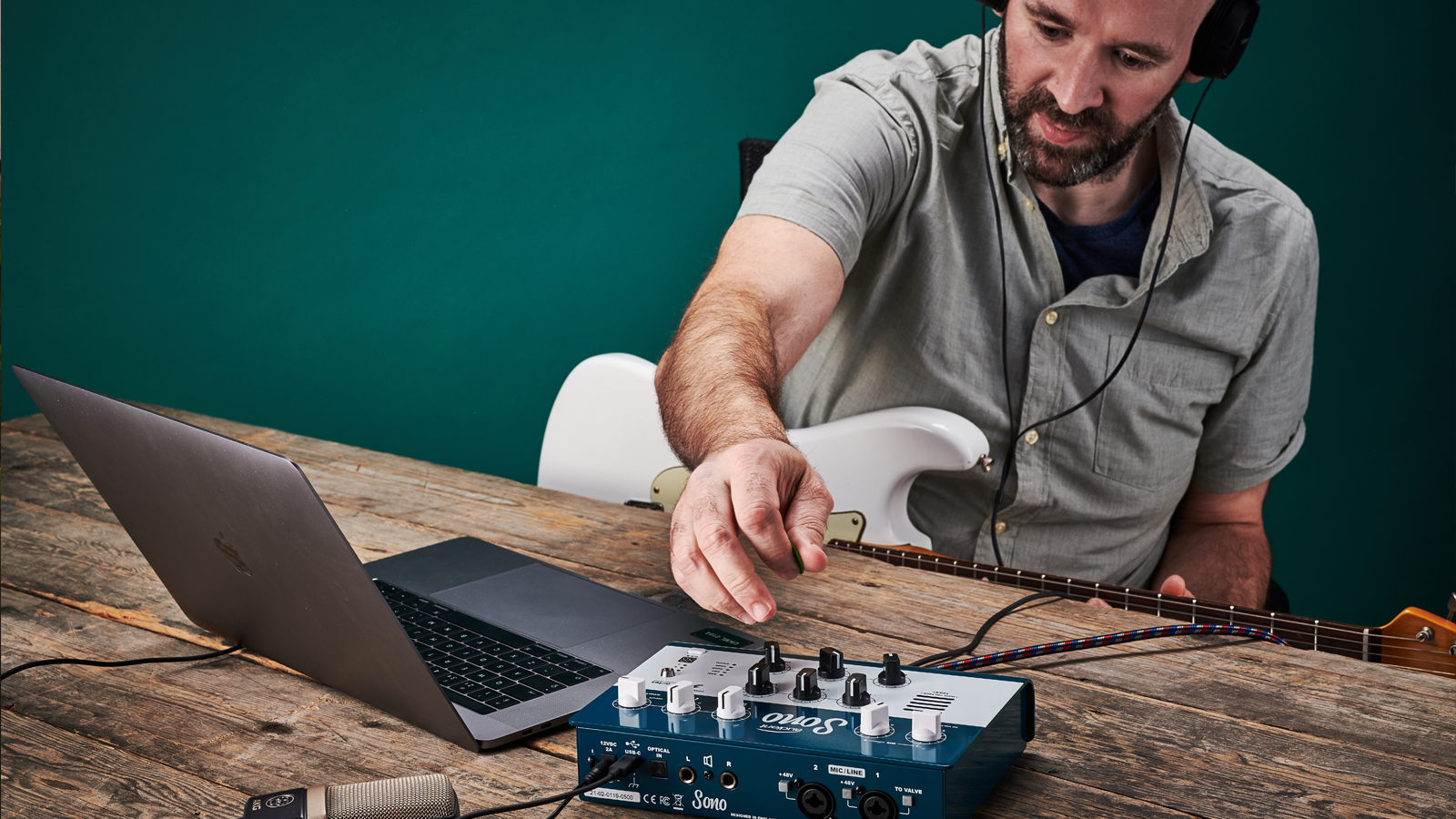
What is an audio interface?
You’ve been writing and riffing your heart out, but you don’t have much to show for your work yet. You want to record what you’ve written, whether to develop your music further or just to send your ideas to the band’s group chat without having to use your weird voice notes drafts. What do you do? Well, first things first, you’re going to need to get an audio interface.
Simply put, an audio interface is a device used to turn your instrument’s sound into ones and zeros for your laptop or PC to process. The newly digitised audio can be recorded into your Digital Audio Workstation (DAW), or heard by other software. Recorded or processed audio, as well as the raw sound going into your interface, is routed back through the headphones or studio monitors you have plugged into the interface so you can hear it.
Audio interfaces come in a variety of shapes and sizes, but the most common are small, portable bus-powered interfaces that have one or two inputs on the front; on cheaper interfaces, these may just be guitar jack inputs, but most will have combi jack/XLR inputs that let you plug either your guitar or a microphone cable in. In short, the audio interface is your key to recording guitar into your computer.
Can you play guitar through an audio interface?
Yes, you can play your guitar through an audio interface! The vast majority of interfaces on the market have inputs that accept 6.35mm jack cables, and many have an ‘instrument’ switch on each channel that allows your guitar to be recorded (or just heard) properly.
You can use an interface to record your guitar, but you could also use it as a gateway to digital effects and amp emulations in your computer; with a pair of studio monitors or studio headphones to hear yourself with, you can use your interface and computer as a hybrid guitar rig.
Your computer is a key part of the equation here, though. If you’re using software like IK Multimedia’s Amplitube 5 to emulate a guitar rig, your computer needs to be beefy enough to process your audio without introducing too much latency – which is when there’s a time difference between you playing a note, and hearing it after processing. Luckily, most computers (and even a good chunk of smartphones) are good enough to handle audio well; just check the system requirements for your software before you buy!
What types of inputs and outputs do I need?
Assuming you're recording at home, and since you’re largely just interested in recording your guitar, your requirements are likely to be pretty basic in terms of the inputs you'll need – and the good news with this is that you don't need to spend considerable sums to start recording.
All of the interfaces we've recommended in this guide include a Hi-Z instrument input which accepts the low output of passive bass and electric guitar pickups – just plug in your guitar cable as you would into your amp and flip the Hi-Z or “Inst” button if there is one.
If you plan on miking up acoustic guitars, pianos or hooking up a vocal mic, then you'll need an interface with more than one input. You'll most likely use an XLR cable, so look for XLR – or even better, combi XLR/jack – connectors. While one is useful, two would mean you could record in stereo for wider dispersion in your mix, or record live takes of songs with guitar and vocals.
It's also worth noting that, if you've splashed some extra cash on a snazzy condenser mic, your interface will need to supply phantom power. Phantom power is a 48V signal sent down the XLR cable to power the microphone’s active circuitry, and is activated with a button or switch on the interface; you’ll need this if you want to hear anything with your condenser mic.
What software do I need?
The software you need as a guitarist is dependent on what you want from your interface. If you want to unlock the potential of digital effects and emulation, in band practices or in a live setting, then you’ll want some modelling software. Great options include IK Multimedia’s Amplitube 5 and TONEX libraries, as well as Positive Grid’s BIAS FX 2.
If you want to record, you’ll need a Digital Audio Workstation or DAW. Most interfaces come bundled with software, so you can get started right away – besides, there are free or trial-version apps aplenty to be found online. I’d recommend you get a DAW anyway, as you can use it to route your guitar signal live – and benefit from software VSTs in your signal chain too.
Does audio interface affect the sound quality on guitar?
Pretty much anything you put between a guitar audio signal and its destination will affect its sound. Your audio interface is an active piece of technology that translates your guitar’s audio to digital information, and will naturally have some impact on what your guitar sounds like – but not in the way you think.
Today, analogue-to-digital conversion is extremely high-resolution and functionally transparent to the human ear. Pretty much all interfaces today are capable of 24-bit/48kHz resolution at bare minimum! As such, your guitar will not sound lower-quality unless you record at a low resolution.
If your guitar does sound worse than you thought, it could be because you’ve not engaged the Inst. switch on the channel it’s going into. This changes the impedance characteristics to match your guitar’s, making the signal work less hard to ‘get in’. Your audio interface is acting as a preamp for your guitar, and needs to be levelled accordingly. Many new interfaces have colorful preamp settings, like Blackstar’s Polar 2 with its tube-amp-emulating Enhance switch, which can bring some life to your sound before you process it digitally.
Is it better to record guitar with a mic or audio interface?
Your audio interface will be receiving your guitar’s signal whether you choose to record it with a microphone or straight in via jack cable to process digitally. Whether one method is better than the other… well, it’s a divisive question! And to be truthful, there's no right or wrong answer here. Many will argue there's nothing quite like the sound of a real amp in a real room, recorded with a microphone – and the majority of recording artists do still do it this way. The process is involved, and can beget great sounds almost by accident.
Conversely, amp modelling technology has never been better, and remains the cheapest way to hear your guitar through expensive equipment. Getting great results this way is no ‘worse’ than getting great results with an expensive amplifier; after all, the results are great! Besides, amp modelling technology has made its way into professional studios and live performance rigs in the most surprising ways. As the tech gets better, more and more big artists are using modelled amps and effects for recording.
What I will say is that, if you’re recording straight in through your interface, the quality of your capture is more important than if you plug into an amp. Keep your cable runs short, and use a DI box if you have one; also, make sure you have healthy volume on your interface’s preamp, otherwise you could introduce noise when you start turning things up in your DAW.
At the end of the day we'd go by the old adage, 'if it sounds good, it is good', no matter whether it was recorded through super expensive mics or a cheap audio interface and modeller combo. Gear envy is not an unusual thing for any of us to feel, but don’t let it spiral into FOMO if your results are already good!
How we test
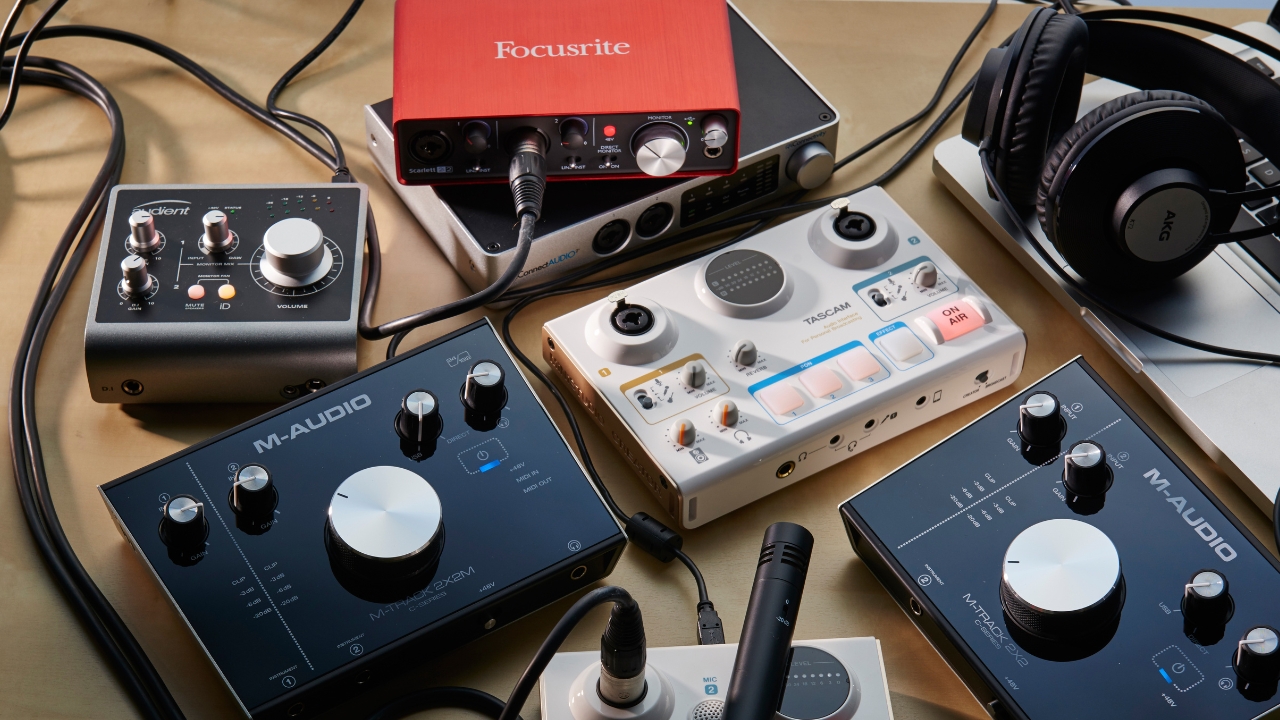
When testing the best audio interfaces for guitar, we give our choices the same stress tests as we would any audio interface, just through the lens of a guitarist. The needs of a guitarist versus that of a musician recording purely 'in the box' are completely different, so for this guide the interfaces we've picked our influenced by our testers who are guitarists themselves..
We've tested a huge amount of audio interfaces over the years which gives us an excellent overview of what will be great for a guitarist. This testing knowledge leads which interfaces make the cut, and will continue to inform us as we test future audio interfaces for guitar players.
To help you understand exactly how we test guitar audio interfaces, we've listed the following steps that make up our review guidelines.
1. Features - First of all we look at all the features the interface has. Whether its physical connections or included software, we want to judge whether or not the interface is up to the task of making great quality guitar recordings from the off.
2. Build quality - Our next step is to check the quality of the unit. We're looking for durability from any interface that we test, so we'll look at the chassis and what it's made of, the sturdiness of the buttons and knobs, as well as the general design ethos.
3. Installation - Next we'll look at the installation process and how easy it is. We'll ascertain whether or not you need to download firmware updates and additional software, how long it the whole process is and that will help inform our testing. We'll also install on both Windows and Mac OS to determine any differences between the two most popular operating systems.
4. Usability - Our next test is the usability of the interface in question. We'll test this by actually using it record guitars, making notes of first how easy it is to perform the actual recording process, then to mark the quality of the results that we get. We'll perform tests recording both direct in guitars as well as miking up and amp to record in a traditional way, or using a condenser mic with an acoustic guitar to help determine just how easy to use the interface is.
5. Sound - It's very subjective, but we'll also be listening throughout the process to determine the sound quality of the audio interface we're reviewing. Most audio interfaces deliver similar sound quality across the board, with sound quality more likely to be determined by the sound going in and the player rather than the interface itself. But it is important to note how good it sounds, how much dynamic range is on offer, and how hard it drives headphones and studio monitors.
Typically we will test an audio interface for at least two weeks before starting our reviews, in some cases even longer. Like the end user, we want to live with the interface as part of our recording setup for a period of time to determine its overall quality. This means integrating it into our usual setup and workflows and seeing how it performs relative to our regular interface and any others we may have tested.
Read more about how we test audio interfaces at MusicRadar.
Latest updates
19/03/25 - The guide has had a significant update to improve navigation on mobile and desktop. New products have been added and the whole guide has had an overhaul in terms of product entries and imagery.
Related buyer's guides
MusicRadar's got your back
- On a tight budget? These are the best budget audio interfaces
- Elevate your content with the best audio interfaces for streaming
- Kick off your playing career with the best beginner guitar amps
- Is space an issue? Here are the best desktop amps
Want all the hottest music and gear news, reviews, deals, features and more, direct to your inbox? Sign up here.
Chris has been the Editor of Total Guitar magazine since 2020. Prior to that, he was at the helm of Total Guitar's world-class tab and tuition section for 12 years. He's a former guitar teacher with 35 years playing experience and he holds a degree in Philosophy & Popular Music. Chris has interviewed Brian May three times, Jimmy Page once, and Mark Knopfler zero times – something he desperately hopes to rectify as soon as possible.
- Matt McCrackenJunior Deals Writer
- James GrimshawFreelance writer
- Daryl RobertsonSenior Deals Writer

